|
fellowcraft
CHAPTER Iv
the masonic manual
robert macoy
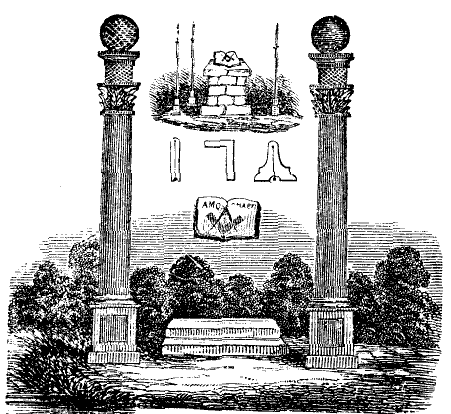
MASONRY is a progressive science, and is divided into different grades,
or degrees, for the more regular advancement in the know ledge of its
mysteries. According to the progress we make, we limit or extend our
inquiries; and, in proportion to our capacity, we attain to a less or
greater degree of perfection.
Masonry includes within its circle almost every branch of polite
learning. Under the veil of its
mysteries is comprehended a regular system of science. Many of its
illustrations, to the narrow mind, may appear unimportant; but the man of
more enlarged faculties will perceive them to be, in the highest degree,
useful and interesting. To please the accomplished scholar, and ingenious
artist, Masonry is wisely planned; and, in the investigation of its latent
doctrines, the philosopher and mathematician may experience equal delight
and satisfaction.
To exhaust the various subjects of which it treats, would transcend the
powers of the brightest genius; still, however, nearer approaches to
perfection may be made; and the man of wisdom will not check the progress
of his abilities, though the task he attempts may at first seem
insurmountable. Perseverance and application remove each difficulty as it
occurs; every step he advances new pleasures open to his view, and
instruction of the noblest kind attends his researches. In the diligent
pursuit of knowledge, the intellectual faculties are employed in promoting
the glory of GOD, and the good of man.
The first degree is well calculated to enforce the duties of morality,
and imprint on the memory the noblest principles which can adorn the human
mind. It is therefore the best introduction to the second degree, which
not only extends the same plan, but comprehends a more diffusive system of
knowledge. Here, practice and theory join,
in qualifying the industrious Mason to share the pleasures which an
advancement of the art must necessarily afford. Listening with attention
to the wise opinions of experienced craftsmen, on important subjects, he
gradually familiarizes his mind to useful instruction, and is soon enabled
to investigate truths of the utmost concern in the general transactions of
life.
The first section of the second degree accurately elucidates the mode
of introduction into that particular grade; and instructs the diligent
craftsman how to proceed in the proper arrangement of the ceremonies used
on the occasion. It qualifies him to judge of their importance, and
convinces him of the necessity of strictly adhering to every established
usage of the order. Many duties, which cement in the firmest union
well-informed brethren, are illustrated in this section; and an
opportunity is given to make such advances in masonry, as will always
distinguish the abilities of those who have arrived at preferment.
The knowledge of this section is absolutely necessary for all
craftsmen; and as it recapitulates the ceremony of initiation, and
contains many other
important particulars, no officer or member of a lodge should be
unacquainted with it.
The following passage of Scripture is appropriate to this degree:
"Thus he shewed me: and bebold, the LORD stood upon a wall made by a
plumb-line, with a plumb-line in his hand. And the LORD said unto me,
AMOS, what seest thou? and I said, a plumbline. Then said the Lord,
Behold, I will set a plumb-linie in the midst of my people Israel: I will
not again pass by them any more." - AMOS, vii. 7, 8.
THE
FOLLOWING ODE MAY BE SUNG:
Come, Craftsmen, assembled our pleasure to share,
Who walk by the
PLUMB, and who work by the SQUARE;
While traveling in love, on the
LEVEL of time,
Sweet hope shall light on to a far better clime.
We'll seek, in our labors, the Spirit Divine
Our temple to bless,
and our hearts to refine;
And thus to our altar a tribute we'll
bring,
While, joined in true friendship, our anthem we sing.
See Order and Beauty rise gently to view,
Each Brother a column, so
perfect and true!
When Order shall cease, and when temples
decay,
May each, fairer columns, immmortal, survey.
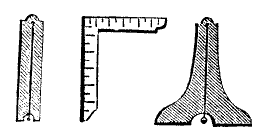
The Plumb is an instrument made use of by oerative
masons, to try perpendiculars; the Square, to square their work,
and the Level, to prove horizontals; but we, as free and accepted
Masons, are taught to make use of them for more noble and glorious
purposes; the Plumb admonishes us to walk uprightly in our several
stations before GOD and man, squaring our actions by the Square of
Virtue, and ever remembering that we are traveling upon the Level
of Time, to "that undiscovered country, from whose bourne no traveler
returns."
The second section of this degree has reference to the origin of the
institution, and views Masonry under two denominations-operative and
speculative. These are separately considered, and the principles on which
both are founded, particularly explained. Their affinity is pointed out,
by allegorical figures and typical representations. The period stipulated
for rewarding merit is fixed, and the inimitable moral to which that
circumstance alludes is explained; the creation of the world is described,
and many other particulars recited, all of which have been carefully
preserved among Masons, and transmitted from one age to another by oral
tradition.
Circumstances of great importance to the fraternity are here
particularized, and many traditional tenets and customs confirmed by
sacred and profane record. The celestial and terrestrial globes are
considered with a minute accuracy; and here the accomplished craftsman may
display his talents to advantage, in the elucidation of the Orders of
Architecture, the Senses of human nature, and the liberal
Arts and Sciences, which are severally classed in a regular
arrangement. In short, this section contains a store of valuable
knowledge, founded on reason and sacred record, both entertaining and
instructive.
By Operative Masonry we allude to a proper application of the useful
rules of architecture, whence a structure will derive figure, strength and
beauty, and whence will result a due proportion and a just correspondence
in all its parts. It furnishes us with dwellings, and convenient shelters
from the vicissitudes and inclemencies of seasons; and while it displays
the effects of human wisdom, as well in the choice as in the arrangement
of the sundry materials of which an edifice is composed, it demonstrates
that a fund of science and industry is implanted in man, for the best,
most salutary and benificent purposes.
By Speculative Masonry, we learn to subdue the passions, act upon the
square, keep a tongue of good report, maintain secrecy, and practise
charity. It is so far interwoven with religion, as to lay us under
obligations to pay that rational homage to the DEITY, which at once
constitutes our duty and our happiness. It leads the contemplative to
view, with reverence and admiration, the glorious worlds of creation, and
inspires him with the most exalted ideas of the perfection of his divine
Creator.
In fix days GOD created the heavens and the earth, and rested upon the
seventh day; the seventh, therefore, our ancient brethren consecrated as a
day of rest from their labors, thereby enjoying frequent opportunities to
contemplate the glorious works of the creation, and to adore their great
CREATOR.
* * * * * * * *
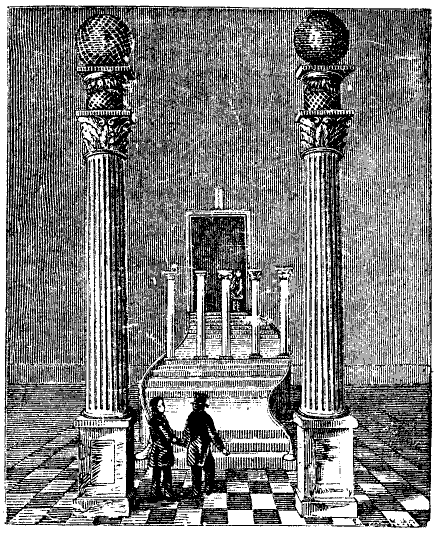
PEACE, UNITY, AND PLENTY are introduced, and their moral application
explained.
* * * * * * * *
The doctrine of the SPHERES is included in the science of astronomy,
and particularly considered in this section.
The globes are two artificial spherical bodies, on the convex
surface of which are represented the countries, seas, and various parts of
the earth, the face of the heavens, the planetary revolutions, and other
important particulars.
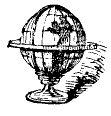 Their principal use,
besides serving as maps to distinguish the outward parts of the earth, and
the situation of the fixed stars, is to illustrate and explain the
phenomena arising from the annual revolution, and the diurnal rotation of
the earth round its own axis. They are invaluable instruments for
improving the mind, and giving it the most distinct idea of any problem or
proposition, as well as enabling it to solve the same. Contemplating these
bodies, we are inspired with a due reverence for the DEITY and his works,
and are induced to encourage the studies of astronomy, geography,
navigation, and the arts dependent on them, by which society has been so
much benefited. Their principal use,
besides serving as maps to distinguish the outward parts of the earth, and
the situation of the fixed stars, is to illustrate and explain the
phenomena arising from the annual revolution, and the diurnal rotation of
the earth round its own axis. They are invaluable instruments for
improving the mind, and giving it the most distinct idea of any problem or
proposition, as well as enabling it to solve the same. Contemplating these
bodies, we are inspired with a due reverence for the DEITY and his works,
and are induced to encourage the studies of astronomy, geography,
navigation, and the arts dependent on them, by which society has been so
much benefited.
Come under consideration in this section; a brief description of them
may not be improper.
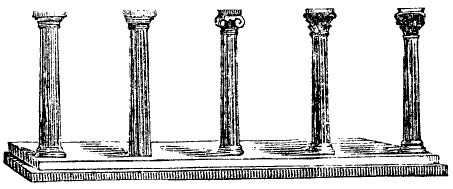
OF ORDER IN ARCHITECTURE
By order in architecture, is meant a system of all the members,
proportions and ornaments of columns and pilasters; or, it is a regular
arrangement of the projecting parts of a building, which, united with
those of a column, form a beautiful, perfect and complete whole.
OF ITS ANTIQUITY
From the first formation of society, order in architecture may be
traced. When the rigor of seasons obliged men to contrive shelter from the
inclemency of the weather, we learn that they first planted trees on end,
and then laid others across, to support a covering. The bands which
connected those trees at top and bottom, are said to have given rise to
the idea of the base and capital of pillars: and, from this simple hint,
originally proceeded the more improved art of
architecture.
The five orders are thus classed: the TUSCAN, DORIC, IONIC, CORINTHIAN
AND COMPOSITE.
THE TUSCAN
 Is the most simple and
solid of the five orders. It was invented in Tuscany, whence it derives
its name. Its column is seven diameters high; and its capital, base and
entablature have but few mouldings. The simplicity of the construction of
this column renders it eligible where ornament would be
superfluous. Is the most simple and
solid of the five orders. It was invented in Tuscany, whence it derives
its name. Its column is seven diameters high; and its capital, base and
entablature have but few mouldings. The simplicity of the construction of
this column renders it eligible where ornament would be
superfluous.
THE DORIC
 Which is plain and
natural, is the most ancient, and was invented by the Greeks. Its column
is eight diameters high, and has seldom any ornaments on base or capital,
except mouldings; though the frieze is distinguished by triglyphs and
metopes, and triglyphs compose the ornaments of the frieze. The solid
composition of this order gives it a preference, in structures where
strength and a noble simplicity are chiefly required. The Doric is the
best proportioned of all the orders. The several parts of which it is
composed are founded on the natural position of solid bodies. In its first
invention it was more simple than in its present state. In after times,
when it began to be adorned, it gained the name of Doric; for when it was
con Which is plain and
natural, is the most ancient, and was invented by the Greeks. Its column
is eight diameters high, and has seldom any ornaments on base or capital,
except mouldings; though the frieze is distinguished by triglyphs and
metopes, and triglyphs compose the ornaments of the frieze. The solid
composition of this order gives it a preference, in structures where
strength and a noble simplicity are chiefly required. The Doric is the
best proportioned of all the orders. The several parts of which it is
composed are founded on the natural position of solid bodies. In its first
invention it was more simple than in its present state. In after times,
when it began to be adorned, it gained the name of Doric; for when it was
con
structed in its primitive and simple form, the name of Tuscan was
conferred on it. Hence the Tuscan precedes the Doric in rank, on account
of its resemblance to that pillar in its original state.
THE IONIC
 Bears a kind of mean
proportion between the more solid and delicate orders. Its column is nine
diameters high; its capital is adorned with volutes, and its cornice has
dentils. There is both delicacy and ingenuity displayed in this pillar;
the invention of which is attributed to the Ionians, as the famous temple
of DIANA, at Ephesus, was of this order. It is said to have been formed
after the model of an agreeable young woman, of an elegant shape, dressed
in her hair; as a contrast to the Doric order, which was formed after that
of a strong, robust man. Bears a kind of mean
proportion between the more solid and delicate orders. Its column is nine
diameters high; its capital is adorned with volutes, and its cornice has
dentils. There is both delicacy and ingenuity displayed in this pillar;
the invention of which is attributed to the Ionians, as the famous temple
of DIANA, at Ephesus, was of this order. It is said to have been formed
after the model of an agreeable young woman, of an elegant shape, dressed
in her hair; as a contrast to the Doric order, which was formed after that
of a strong, robust man.
THE CORINTHIAN
 The richest of the
five orders, is deemed a master-piece of art. Its column is tenl diameters
high, and its capital is adorned with two rows of leaves, and eight
volutes, which sustain the abacus. The frieze is ornamented with curious
devices, the cornice with dentils and modillions. This order is used in
stately and superb structures. The richest of the
five orders, is deemed a master-piece of art. Its column is tenl diameters
high, and its capital is adorned with two rows of leaves, and eight
volutes, which sustain the abacus. The frieze is ornamented with curious
devices, the cornice with dentils and modillions. This order is used in
stately and superb structures.
It was invented at Corinth, by CALLIMACHUS, who is said to have taken
the hint of the capital of this pillar from the following remarkable
circumstance. Accidentally passing by the tomb of a young lady, he
perceived a basket of toys, covered with a tile, placed over an acanthus
root, having been left there by her nurse. As the branches grew up, they
encompassed the basket, until arriving at the tile, they met with an
obstruction, and bent downwards. Callimachus, struck with the object, set
about imitating the figure; the vase of the capital he made to represent
the basket; the abacus the tile, and the volutes the bending leaves.
THE COMPOSITE
 Is compounded of the
other orders, and was contrived by the Romans. Its capital has the two
rows of leaves of the Corinthian and the volutes of the Ionic. Its column
has quarter-rounds, as the Tuscan and Doric order; is ten diameters high,
and its cornice has dentils, or simple modillions. This pillar is
generally found in buildings where strength, elegance and beauty are
displayed. Is compounded of the
other orders, and was contrived by the Romans. Its capital has the two
rows of leaves of the Corinthian and the volutes of the Ionic. Its column
has quarter-rounds, as the Tuscan and Doric order; is ten diameters high,
and its cornice has dentils, or simple modillions. This pillar is
generally found in buildings where strength, elegance and beauty are
displayed.
OF TIRE INVENTION OF ORDER IN ARCHITECTURE
The ancient and original orders of architecture, revered by Masons, are
no more than three, the Doric, Ionic and Corinthian, which were invented
by the Greeks. To these, the Romans have
added two, the Tuscan, which they made plainer than the Doric, and the
Composite, which was more ornamental, if not more beautiful, than the
Corinthian. The first three orders alone, however, show invention and
particular character, and essentially differ from each other; the two
others have nothing but what is borrowed, and differ only accidentally;
the Tuscan is the Doric in its earliest state; and the Composite is the
Corinthian enriched with the Ionic. To the Greeks, therefore, and not to
the Romans, we are indebted for what is great, judicious and distinct in
architecture.
An analysis of the human faculties is next given in this section, in
which the five external senses particularly claim attention.
The senses we are to consider as the gifts of nature, and though not
the acquisition of our reasoning faculty, yet in the use of them, are
still subject to reason. Reason, properly employed, confirms the documents
of nature, which are always true and wholesome; she distinguishes the good
from the bad; rejects the last with modesty, adheres to the first with
reverence. The objects of human knowledge are innumerable; the channels by
which this knowledge is conveyed are few. Among these, the perception of
external things by the senses, and the information we receive from human
testimony, are not the least
considerable;
the analogy between them is obvious. In the testimony of nature, given
by the senses, as well as in human testimony, given by information, things
are signified by signs. In one as well as the other, the mind, either by
original principles or by custom, passes from the sign to the conception
and belief of the thing signified. The signs in the natural language, as
well as the signs in our original perceptions, have the same signification
in all climates and nations, and the skill of interpreting them is not
acquired, but innate.
Having made these observations, we shall proceed to give a brief
description of the five senses.
HEARING
Is that sense by which we distinguish sounds, and are capable of
enjoying all the agreeable charms of music. By it we are enabled to enjoy
the pleasures of society, and reciprocally to communicate to each other
our thoughts and intentions, our purposes and desires; and thus our reason
is rendered capable of exerting its utmost power and energy. The wise and
beneficent Author of Nature, intended by the formation of this sense, that
we should be social creatures, and receive the greatest and most important
part of our knowledge from social intercourse with each other. For these
purposes we are endowed with hearing, that by a proper exertion of our
rational powers, our happiness may be
complete.
SEEING
Is that sense by which we distinguish objects, and in an instant of
time, without change of place or situation, view armies in battle array,
figures of the most stately structures, and all the agreeable variety
displayed in the landscape of nature. By this sense we find our way on the
pathless ocean, traverse the globe of earth, determine its figure and
dimensions, and delineate any region or quarter of it. By it we measure
the planetary orbs, and make new discoveries in the sphere of the fixed
stars. Nay, more, by it we perceive the tempers and dispositions, the
passions and affections of our fellow creatures, when they wish most to
conceal them; so that, though the tongue may be taught to lie and
dissemble, the countenance will display the hypocrisy to the discerning
eye. In fine, the rays of light which administer to this sense, are the
most astonishing parts of the animated creation, and render the eye a
peculiar object of admiration.
Of all the faculties, SIGHT is the noblest. The structure of the eye,
and its appurtenances, evince the admirable contrivance of nature for
performing all its various external and internal motions; while the
variety displayed in the eyes of different animals, suited to their
several ways of life, clearly demonstrates this organ to be the
master-piece of nature's works.
FEELING
Is that sense by which we distinguish the different qualities of
bodies; such as heat and cold, hardness and softness, roughness and
smoothness, figure, solidity, motion and extension.
These three senses, hearing, seeing, and feeling, are deemed peculiarly
essential among masons.
SMELLING
Is that sense by which we distinguish odors, the various kinds of which
convey different impressions to the mind. Animal and vegetable bodies, and
indeed most other bodies, while exposed to the air, continually send forth
effluvia of vast subtilty, as well in a state of life and growth, as in
the state of fermentation and putrefaction. These effiuvia, being drawn
into the nostrils along with the air, are the means by which all bodies
are distinguished. Hence it is evident, that there is a manifest
appearance of design in the great Creator's having planted the organ of
smell in the inside of that canal, through which the air continually
passes in respiration.
TASTING
Enables us to make a proper distinction in the choice of our food. The
organ of this sense guards the entrance of the alimentary canal, as that
of smelling guards the entrance of the canal for
respiration. From the situation of both these organs, it is plain that
they were intended by nature to distinguish wholesome food from that which
is nauseous. Every thing that enters into the stomach must undergo the
scrutiny of tasting; and by it we are capable of discerning the changes
which the same body undergoes in the different compositions of art,
cookery, chemistry, pharmacy, &c.
Smelling and tasting are inseparately connected, and it is by the
unnatural kind of life men commonly lead in society, that these senses are
rendered less fit to perform their natural offices.
The proper use of these five senses enables us to form just and
accurate notions of the operations of nature; and when we reflect on the
objects with which our senses are gratified, we become conscious of them,
and are enabled to attend to them, till they become familiar objects of
thought.
On the mind all our knowledge must depend; what, therefore, can be a
more proper subject for the investigation of Masons?
To sum up the whole of this transcendent measure of GOD'S bounty to
man, we shall add, that memory, imagination, taste, reasoning, moral
perception, and all the active powers of the soul, present a vast and
boundless field for philosophical disquisition, which far exceeds human
enquiry, and are peculiar mysteries, known only to nature, and to nature's
God, to whom all are indebted for creation, reservation, and every
blessing we enjoy.
Are also illustrated in this section. A brief analysis of the character
of each, may not, therefore, be inappropriate in this place.
GRAMMAR
Is the key by which alone the door can be opened to the understanding
of speech. It is Grammar which reveals the admirable art of language, and
unfolds its various constituent parts, its names, definitions, and
respective offices; it unravels, as it were, the thread of which the web
of speech is composed. These reflections seldom occur to any one before
their acquaintance with the art; yet it is most certain, that, without a
knowledge of Grammar, it is very difficult to speak with propriety,
precision, and purity.
RHETORIC
It is by Rhetoric that the art of speaking eloquently is acquired. To
be an eloquent speaker, in the proper sense of the word, is far from being
either a common or an easy attainment: it is the art of being persuasive
and commanding; the art, not only of pleasing the fancy, but of speaking
both to the understanding and to the heart.
LOGIC
Is that science which directs us how to form clear and distinct ideas
of things, and thereby prevents us from being misled by their similitude
or resemblance. Of all the human sciences, that concerning man is certainly
most worthy of the human mind, and the proper manner of conducting its
several powers in the attainment of truth and knowledge. This science
ought to be cultivated as the foundation or ground-work of our inquiries;
particularly, in the pursuit of those sublime principles which claim our
attention as masons.
ARITHMETIC
Is the art of numbering, or that part ot the mathematics which
considers the properties of numbers in general. We have but a very
imperfect idea of things without quantity, and as imperfect of quantity
itself, without the help of Arithmetic. All the works of the Almighty are
made in number, weight and measure; therefore, to understand them rightly,
we ought to understand arithmetical calculations, and the greater
advancement we make in the mathematical sciences, the more capable we
shall be of considering such things as are the ordinary objects of our
conceptions, and be thereby led to a more comprehensive knowledge of our
great Creator, and the works of the creation.
GEOMETRY
Treats of the powers and properties of magnitudes in general, where
length, breadth and thickness are considered - from a point to a
line, from a line to a superfices, and from a superfices to
a solid.
A point is the beginning of all geometrical matter.
A line is a continuation of the
same.
A superfices is length and breadth without a
given thickness.
A solid is length and breadth, with
a given thickness, which forms a cube and comprehends the whole.
OF THE ADVANTAGES OF GEOMETRY
By this science the architect is enabled to construct his plans, and
execute his designs; the general, to arrange his soldiers; the engineer,
to mark out grounds for encampments; the geographer, to give us the
dimensions of the world, and all things therein contained; to delineate
the extent of seas, and specify the divisions of empires, kingdoms and
provinces. By it, also, the astronomer is enabled to make his
observations, and to fix the duration of times and seasons, years and
cycles. In fine, Geometry is the foundation of architecture, and the root
of the mathematics.
MUSIC
Is that elevated science which affects the passions by sound. There are
few who have not felt its charms, and acknowledged its expressions to be
intelligible to the heart. It is a language of delightful sensations, far
more eloquent than words; it breathes to the ear the clearest intimations;
it touches and gently agitates the agreeable and sublime passions; it
wraps us in melancholy, and elevates us in joy; it dissolves and enflames; it melts us
in tenderness, and excites us to war. This science is truly congenial to
the nature of man; for by its powerful charms, the most discordant
passions may be harmonized and brought into perfect unison: but it never
sounds with such seraphic harmony, as when employed in singing hymns of
gratitude to the Creator of the universe.
ASTRONOMY
Is that sublime science which inspires the contemplative mind to soar
aloft, and read the wisdom, strength, and beauty of the great Creator in
the heavens. How nobly eloquent of the Deity is the celestial hemisphere!
- spangled with the most magnificent heralds of his infinite glory! They
speak to the whole universe; for there is no speech so barbarous, but
their language is understood; nor nation so distant, but their voices are
heard among them.
The heavens proclaim the glory of GOD;
The firmament declareth the
works of his hands.
Assisted by Astronomy, we ascertain the laws which govern the heavenly
bodies, and by which their motions are directed; investigate the power by
which they circulate in their orbs, discover their size, determine their
distance, explain their various phenomena, and correct the fallacy of the
senses by the light of truth.
Here an emblem of PLENTY is introduced and explained.
* * * * * * * *
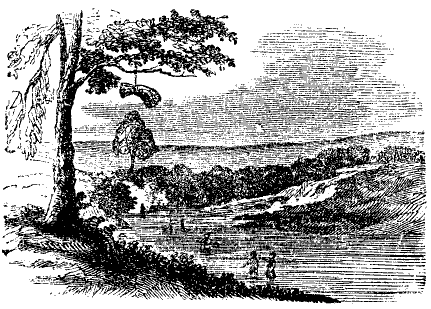
CORN. WINE. OIL.
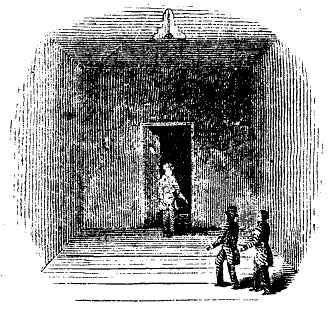
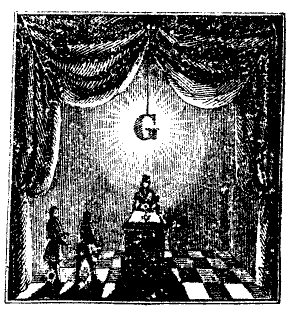
Geometry, the first and noblest of sciences, is the Basis on which the
superstructure of Free-masonry is erected. By Geometry we may curiously
trace nature through her various windings, to her most concealed recesses.
By it, we discover the power, wisdom and goodness of the GRAND ARTIFICER
of the universe, and view with delight the proportions which connect this
vast machine. By it, we discover how the planets move in their respective
orbits, and demonstrate their various revolutions. By it we account for
the return of the seasons, and the variety of scenes which each season
displays to the discerning eye. Numberless worlds are
around us, all framed by the same Divine Artist which roll through the vast
expanse, and are all conducted by the same unerring law of nature.
A survey of nature, and the observation of her beautiful proportions,
first determined man to imitate the divine plan, and study symmetry and
order. This gave rise to societies, and birth to every useful art. The
architect began to design; and the plans which he laid down, being
improved by time and experience, have produced works which are the
admiration of every age.
The lapse of time, the ruthless hand of ignorance, and the devastations
of war, have laid waste and destroyed many valuable monuments of
antiquity, on which the utmost exertions of human genius have been
employed. Even the Temple of Solomon, so spacious and magnificent, and
constructed by so many celebrated artists, escaped not the unsparing
ravages of barbarous force. Freemasonry, notwithstanding, has still
survived. The attentive ear receives the sound from the
instructive tongue, and the mysteries of masonry are safely lodged
in the repository of faithful breasts. Tools and implements of
architecture, and symbolie emblems, most expressive, are selected by the
fraternity, to imprint on the mind wise and serious truths; and thus,
through a succession of ages, are transmitted unimpaired the most
excellent tenets of out institution.
Thus end the two sections of the second lecture, which, with the
ceremony used at the opening and closing the lodge, comprehend the second
degree of masonry. This lecture contains a regular system of science,
demonstrated on the clearest principles, and founded on the most stable
foundation.
BROTHER: - Being passed to the second degree of Free-masonry, we
congratulate you on your preferment. The internal, and not the external
qualifications of a man, are what masonry regards. As you increase in
knowledge, you will improve in social intercourse.
It is unnecessary to recapitulate the duties which, as a Fellow Craft,
you are bound to discharge, or to enlarge on the necessity of a strict
adherence to them, as your own experience must have established their
value. Our laws and regulations you are strenuously to support; and be
always ready to assist in seeing them duly executed. You are not to
palliate, or aggravate, the offences of your brethren; but in the decision
of every trespass against our rules. you are to judge
with candor, admonish with friendship, and reprehend with justice.
The study of the liberal arts, that valuable branch of education, which
tends so effectually to polish and adorn the mind, is earnestly
recommended to your consideration; especially the science of Geometry,
which is established as the basis our art. Geometry, or Masonry,
originally synonymous terms, being of a divine and moral nature, is
enriched with the most useful knowledge; while it proves the wonderful
properties of nature, it demonstrates the more important truths of
morality.
Your past behavior and regular deportment have merited the honor which
we have now conferred; and in your new character, it is expected that you
will conform to the principles of the order, by steadily persevering in
the practice of every commendable virtue. Such is the nature of your
enagemernts as a Fellow Craft, and to these duties you are bound by the
most sacred
ties.
back to top |
![]()








 Their principal use,
besides serving as maps to distinguish the outward parts of the earth, and
the situation of the fixed stars, is to illustrate and explain the
phenomena arising from the annual revolution, and the diurnal rotation of
the earth round its own axis. They are invaluable instruments for
improving the mind, and giving it the most distinct idea of any problem or
proposition, as well as enabling it to solve the same. Contemplating these
bodies, we are inspired with a due reverence for the DEITY and his works,
and are induced to encourage the studies of astronomy, geography,
navigation, and the arts dependent on them, by which society has been so
much benefited.
Their principal use,
besides serving as maps to distinguish the outward parts of the earth, and
the situation of the fixed stars, is to illustrate and explain the
phenomena arising from the annual revolution, and the diurnal rotation of
the earth round its own axis. They are invaluable instruments for
improving the mind, and giving it the most distinct idea of any problem or
proposition, as well as enabling it to solve the same. Contemplating these
bodies, we are inspired with a due reverence for the DEITY and his works,
and are induced to encourage the studies of astronomy, geography,
navigation, and the arts dependent on them, by which society has been so
much benefited.
 Is the most simple and
solid of the five orders. It was invented in Tuscany, whence it derives
its name. Its column is seven diameters high; and its capital, base and
entablature have but few mouldings. The simplicity of the construction of
this column renders it eligible where ornament would be
superfluous.
Is the most simple and
solid of the five orders. It was invented in Tuscany, whence it derives
its name. Its column is seven diameters high; and its capital, base and
entablature have but few mouldings. The simplicity of the construction of
this column renders it eligible where ornament would be
superfluous. Which is plain and
natural, is the most ancient, and was invented by the Greeks. Its column
is eight diameters high, and has seldom any ornaments on base or capital,
except mouldings; though the frieze is distinguished by triglyphs and
metopes, and triglyphs compose the ornaments of the frieze. The solid
composition of this order gives it a preference, in structures where
strength and a noble simplicity are chiefly required. The Doric is the
best proportioned of all the orders. The several parts of which it is
composed are founded on the natural position of solid bodies. In its first
invention it was more simple than in its present state. In after times,
when it began to be adorned, it gained the name of Doric; for when it was
con
Which is plain and
natural, is the most ancient, and was invented by the Greeks. Its column
is eight diameters high, and has seldom any ornaments on base or capital,
except mouldings; though the frieze is distinguished by triglyphs and
metopes, and triglyphs compose the ornaments of the frieze. The solid
composition of this order gives it a preference, in structures where
strength and a noble simplicity are chiefly required. The Doric is the
best proportioned of all the orders. The several parts of which it is
composed are founded on the natural position of solid bodies. In its first
invention it was more simple than in its present state. In after times,
when it began to be adorned, it gained the name of Doric; for when it was
con Bears a kind of mean
proportion between the more solid and delicate orders. Its column is nine
diameters high; its capital is adorned with volutes, and its cornice has
dentils. There is both delicacy and ingenuity displayed in this pillar;
the invention of which is attributed to the Ionians, as the famous temple
of DIANA, at Ephesus, was of this order. It is said to have been formed
after the model of an agreeable young woman, of an elegant shape, dressed
in her hair; as a contrast to the Doric order, which was formed after that
of a strong, robust man.
Bears a kind of mean
proportion between the more solid and delicate orders. Its column is nine
diameters high; its capital is adorned with volutes, and its cornice has
dentils. There is both delicacy and ingenuity displayed in this pillar;
the invention of which is attributed to the Ionians, as the famous temple
of DIANA, at Ephesus, was of this order. It is said to have been formed
after the model of an agreeable young woman, of an elegant shape, dressed
in her hair; as a contrast to the Doric order, which was formed after that
of a strong, robust man. The richest of the
five orders, is deemed a master-piece of art. Its column is tenl diameters
high, and its capital is adorned with two rows of leaves, and eight
volutes, which sustain the abacus. The frieze is ornamented with curious
devices, the cornice with dentils and modillions. This order is used in
stately and superb structures.
The richest of the
five orders, is deemed a master-piece of art. Its column is tenl diameters
high, and its capital is adorned with two rows of leaves, and eight
volutes, which sustain the abacus. The frieze is ornamented with curious
devices, the cornice with dentils and modillions. This order is used in
stately and superb structures. Is compounded of the
other orders, and was contrived by the Romans. Its capital has the two
rows of leaves of the Corinthian and the volutes of the Ionic. Its column
has quarter-rounds, as the Tuscan and Doric order; is ten diameters high,
and its cornice has dentils, or simple modillions. This pillar is
generally found in buildings where strength, elegance and beauty are
displayed.
Is compounded of the
other orders, and was contrived by the Romans. Its capital has the two
rows of leaves of the Corinthian and the volutes of the Ionic. Its column
has quarter-rounds, as the Tuscan and Doric order; is ten diameters high,
and its cornice has dentils, or simple modillions. This pillar is
generally found in buildings where strength, elegance and beauty are
displayed.


